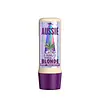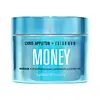What's inside
What's inside
 Key Ingredients
Key Ingredients

 Benefits
Benefits

 Concerns
Concerns

 Ingredients Side-by-side
Ingredients Side-by-side

Water
Skin ConditioningStearyl Alcohol
EmollientSilicone Quaternium-26
EmollientBehentrimonium Chloride
PreservativeCetyl Alcohol
EmollientParfum
MaskingIsopropyl Alcohol
SolventBenzyl Alcohol
PerfumingSodium Benzoate
MaskingDisodium EDTA
Citric Acid
BufferingPolysorbate 20
EmulsifyingLimonene
PerfumingHistidine
HumectantGlycerin
HumectantButylene Glycol
HumectantSodium Hydroxide
BufferingTerminalia Ferdinandiana Fruit Extract
AntioxidantLeptospermum Scoparium Leaf Extract
Skin ConditioningCI 17200
Cosmetic ColorantCI 42090
Cosmetic ColorantWater, Stearyl Alcohol, Silicone Quaternium-26, Behentrimonium Chloride, Cetyl Alcohol, Parfum, Isopropyl Alcohol, Benzyl Alcohol, Sodium Benzoate, Disodium EDTA, Citric Acid, Polysorbate 20, Limonene, Histidine, Glycerin, Butylene Glycol, Sodium Hydroxide, Terminalia Ferdinandiana Fruit Extract, Leptospermum Scoparium Leaf Extract, CI 17200, CI 42090
Water
Skin ConditioningStearyl Alcohol
EmollientDimethicone
EmollientCetyl Alcohol
EmollientStearamidopropyl Dimethylamine
EmulsifyingButylene Glycol
HumectantDicetyldimonium Chloride
EmulsifyingBehentrimonium Chloride
PreservativePropanediol
SolventHydrolyzed Vegetable Protein Pg-Propyl Silanetriol
Skin ConditioningCitric Acid
BufferingChlorella Pyrenoidosa Extract
Skin ConditioningChondrus Crispus Extract
Skin ConditioningUndaria Pinnatifida Extract
Skin ConditioningLaminaria Saccharina Extract
Skin ProtectingCeteareth-20
CleansingDimethiconol
EmollientPhenoxyethanol
PreservativePPG-26-Buteth-26
Skin ConditioningApigenin
AntioxidantOleanolic Acid
Skin ConditioningBiotinoyl Tripeptide-1
Crambe Maritima Leaf Extract
Skin ConditioningParfum
MaskingChlorphenesin
AntimicrobialPEG-40 Hydrogenated Castor Oil
EmulsifyingIsopropyl Alcohol
SolventCaprylyl Glycol
EmollientPropylene Glycol
HumectantPotassium Benzoate
PreservativePotassium Sorbate
PreservativeDisodium EDTA
Benzyl Salicylate
PerfumingAlpha-Isomethyl Ionone
PerfumingCI 42090
Cosmetic ColorantCI 60730
Cosmetic ColorantWater, Stearyl Alcohol, Dimethicone, Cetyl Alcohol, Stearamidopropyl Dimethylamine, Butylene Glycol, Dicetyldimonium Chloride, Behentrimonium Chloride, Propanediol, Hydrolyzed Vegetable Protein Pg-Propyl Silanetriol, Citric Acid, Chlorella Pyrenoidosa Extract, Chondrus Crispus Extract, Undaria Pinnatifida Extract, Laminaria Saccharina Extract, Ceteareth-20, Dimethiconol, Phenoxyethanol, PPG-26-Buteth-26, Apigenin, Oleanolic Acid, Biotinoyl Tripeptide-1, Crambe Maritima Leaf Extract, Parfum, Chlorphenesin, PEG-40 Hydrogenated Castor Oil, Isopropyl Alcohol, Caprylyl Glycol, Propylene Glycol, Potassium Benzoate, Potassium Sorbate, Disodium EDTA, Benzyl Salicylate, Alpha-Isomethyl Ionone, CI 42090, CI 60730
Ingredients Explained
These ingredients are found in both products.
Ingredients higher up in an ingredient list are typically present in a larger amount.
This ingredient is a preservative and often used for it's anti-static properties. You'll most likely see this ingredient in hair conditioners.
It does not cause irritation or sensitization in leave-on products at 1-5%.
Butylene Glycol (or BG) is used within cosmetic products for a few different reasons:
Overall, Butylene Glycol is a safe and well-rounded ingredient that works well with other ingredients.
Though this ingredient works well with most skin types, some people with sensitive skin may experience a reaction such as allergic rashes, closed comedones, or itchiness.
Learn more about Butylene GlycolCetyl Alcohol is a fatty alcohol. Fatty Alcohols are most often used as an emollient or to thicken a product.
Its main roles are:
Though it has "alcohol" in the name, it is not related to denatured alcohol or ethyl alcohol.
The FDA allows products labeled "alcohol-free" to have fatty alcohols.
Learn more about Cetyl AlcoholCi 42090 is a synthetic dye created from petroleum. It is used to give a bright blue color to cosmetics, medicine, and food.
Citric Acid is an alpha hydroxy acid (AHA) naturally found in citrus fruits like oranges, lemons, and limes.
Like other AHAs, citric acid can exfoliate skin by breaking down the bonds that hold dead skin cells together. This helps reveal smoother and brighter skin underneath.
However, this exfoliating effect only happens at high concentrations (20%) which can be hard to find in cosmetic products.
Due to this, citric acid is usually included in small amounts as a pH adjuster. This helps keep products slightly more acidic and compatible with skin's natural pH.
In skincare formulas, citric acid can:
While it can provide some skin benefits, research shows lactic acid and glycolic acid are generally more effective and less irritating exfoliants.
Most citric acid used in skincare today is made by fermenting sugars (usually from molasses). This synthetic version is identical to the natural citrus form but easier to stabilize and use in formulations.
Read more about some other popular AHA's here:
Learn more about Citric AcidDisodium EDTA plays a role in making products more stable by aiding other preservatives.
It is a chelating agent, meaning it neutralizes metal ions that may be found in a product.
Disodium EDTA is a salt of edetic acid and is found to be safe in cosmetic ingredients.
Learn more about Disodium EDTAIsopropyl Alcohol is more commonly known as rubbing alcohol. It is most commonly used as a solvent, meaning it helps other ingredients dissolve.
This ingredient is an astringent alcohol. Astringent alcohols may also irritate skin as they high amounts may strip away your skin's natural oils.
Other types of astringent alcohols include:
According to the National Rosacea Society based in the US, you should be mindful of products with these alcohols in the top half of ingredients.
Any type of sanitizing product will have high amounts of alcohol to help kill bacteria and viruses.
Learn more about Isopropyl AlcoholParfum is a catch-all term for an ingredient or more that is used to give a scent to products.
Also called "fragrance", this ingredient can be a blend of hundreds of chemicals or plant oils. This means every product with "fragrance" or "parfum" in the ingredients list is a different mixture.
For instance, Habanolide is a proprietary trade name for a specific aroma chemical. When used as a fragrance ingredient in cosmetics, most aroma chemicals fall under the broad labeling category of “FRAGRANCE” or “PARFUM” according to EU and US regulations.
The term 'parfum' or 'fragrance' is not regulated in many countries. In many cases, it is up to the brand to define this term.
For instance, many brands choose to label themselves as "fragrance-free" because they are not using synthetic fragrances. However, their products may still contain ingredients such as essential oils that are considered a fragrance by INCI standards.
One example is Calendula flower extract. Calendula is an essential oil that still imparts a scent or 'fragrance'.
Depending on the blend, the ingredients in the mixture can cause allergies and sensitivities on the skin. Some ingredients that are known EU allergens include linalool and citronellol.
Parfum can also be used to mask or cover an unpleasant scent.
The bottom line is: not all fragrances/parfum/ingredients are created equally. If you are worried about fragrances, we recommend taking a closer look at an ingredient. And of course, we always recommend speaking with a professional.
Learn more about ParfumStearyl Alcohol is a type of fatty alcohol from stearic acid. It is a white, waxy compound used to emulsify ingredients.
Fatty Alcohols are most often used as an emollient or to thicken a product. Emollients help soothe and hydrate the skin by trapping moisture.
They are usually derived from natural fats and oils and therefore do not have the same drying or irritating effect as solvent alcohols. FDA allows products labeled "alcohol-free" to have fatty alcohols.
Learn more about Stearyl AlcoholWater. It's the most common cosmetic ingredient of all. You'll usually see it at the top of ingredient lists, meaning that it makes up the largest part of the product.
So why is it so popular? Water most often acts as a solvent - this means that it helps dissolve other ingredients into the formulation.
You'll also recognize water as that liquid we all need to stay alive. If you see this, drink a glass of water. Stay hydrated!
Learn more about Water